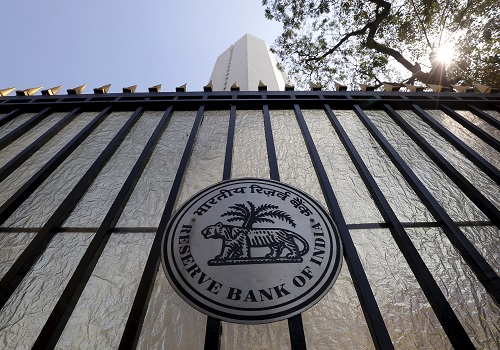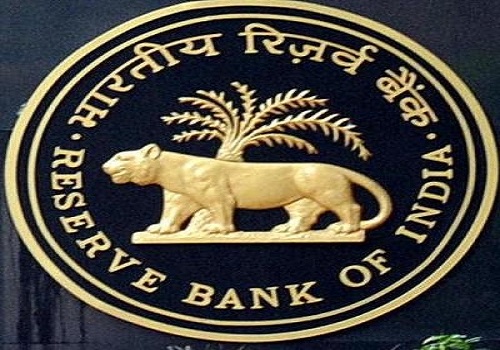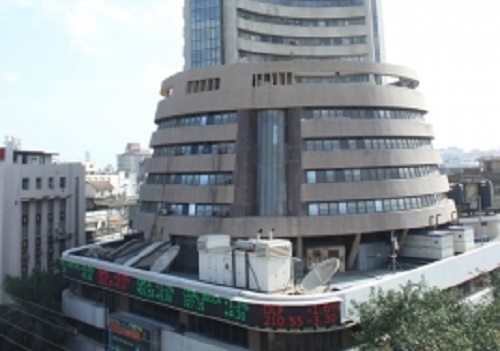Gold trading range for the day is 61585-62415 -Kedia Advisory

Follow us Now on Telegram ! Get daily 10 - 12 important updates on Business, Finance and Investment. Join our Telegram Channel
Gold:
Gold exhibited a marginal gain of 0.16%, settling at 61968, as investors eagerly awaited key U.S. economic data that could influence the tone of the Federal Reserve's policy meeting next week. Fed officials signaled a cautious approach, indicating the need for more inflation data before considering any rate cuts, setting the baseline for potential cuts in the third quarter. The ECB is also anticipated to maintain its monetary policy, contributing to the overall global economic sentiment. Lower interest rates, often associated with holding bullion, continue to decrease the opportunity cost of investing in gold, supporting its demand. However, in India, the government's decision to raise the import duty on gold and silver findings, as well as coins of precious metals to 15% from January 22, has added a layer of complexity to the market. Physical gold buying in India remained lackluster despite a correction in local prices, with dealers offering discounts of up to $9 an ounce over official domestic prices. Contrastingly, demand for gold picked up in China and Hong Kong ahead of Lunar New Year festivities, illustrating regional variations in consumer sentiment. Chinese premiums ranged between $42-$54.2 per ounce over spot prices, slightly lower than the previous week's range of $45-$51. Technically, the gold market is experiencing short covering, with a 9.95% drop in open interest to 5873, coupled with a price increase of 100 rupees. Gold finds support at 61775, and breaking below could test 61585 levels. On the upside, resistance is expected at 62190, with a move above potentially leading to further testing at 62415.
Trading Ideas:
* Gold trading range for the day is 61585-62415.
* Gold steadied as investors await U.S. economic data and Fed’s meeting.
* The Fed officials have stated that they need more inflation data before considering a rate cut.
* The European Central Bank is expected to keep monetary policy steady.
Silver:
Silver closed up by 0.2% at 70957, benefiting from a weakening dollar ahead of crucial U.S. economic reports on durable goods orders, new home sales, fourth-quarter GDP, and personal income and spending. The Bank of Japan maintained its ultra-loose policy, in line with expectations, and Federal Reserve Governor Christopher Waller's remarks suggested a cautious stance on rapid rate cuts, prompting investors to closely monitor further comments from Fed members for a clearer outlook. A sharper-than-expected decline in U.S. jobless claims highlighted a historically tight labor market, tempering expectations for interest rate cuts. Strong U.S. retail sales data and hawkish comments from policymakers have led to a recalibration of bets on monetary easing. Investors are now awaiting signals from the European Central Bank's policy meeting later this week, seeking clarity on the timing and pace of potential interest rate cuts. The focus this week includes the U.S. flash PMI report, fourth-quarter advance GDP estimates, and personal consumption expenditures data. While the Fed is expected to keep rates unchanged at the end of the policy meeting, expectations for the timing of the first interest rate cut have been adjusted, according to CME's FedWatch Tool. Technically, the silver market is undergoing short covering, with a 3.02% drop in open interest to 29901, accompanied by a price increase of 141 rupees. Silver finds support at 70725, and breaking below could test 70490 levels. On the upside, resistance is expected at 71200, and a move above could lead to further testing at 71440.
Trading Ideas:
* Silver trading range for the day is 70490-71440.
* Silver gains as dollar dipped ahead of U.S. reports on durable goods orders, fourth quarter GDP
* Bank of Japan retains ultra-loose policy and yield curve control policy
* Federal Reserve Governor Christopher Waller sees no need for fast rate cuts
Crude oil:
Crude oil faced a decline of -1.39%, settling at 6178, as traders grappled with contrasting factors of rising crude supply in Libya and Norway against production outages in the United States and geopolitical tensions. The market remains highly volatile with uncertainties surrounding various supply and demand indicators. Norway's crude production exceeded expectations, rising to 1.85 million barrels per day (bpd) in December, compared to the previous month's 1.81 million bpd, as reported by the Norwegian Offshore Directorate (NOD). In Libya, production resumed at the Sharara oilfield (300,000 bpd) on January 21 after protests disrupted output earlier this month. However, supply constraints persist in the United States. The International Energy Agency (IEA) raised its 2024 global oil demand growth forecast, predicting an increase of 1.24 million bpd, in contrast to OPEC's projection of 2.25 million bpd. U.S. crude stocks fell more than expected, but gasoline and distillate inventories rose in the week ending January 12, according to the Energy Information Administration (EIA). Crude stocks at the Cushing, Oklahoma, delivery hub also decreased by 2.1 million barrels. Technically, the market is witnessing long liquidation, marked by a 3.95% drop in open interest to 11147, alongside a price decline of -87 rupees. Crude oil finds support at 6109, and breaking below could test 6040 levels. On the upside, resistance is anticipated at 6256, with a move above potentially leading to further testing at 6334.
Trading Ideas:
* Crudeoil trading range for the day is 6040-6334.
* Crude oil prices dropped due to rising supply in Libya and Norway
* Production at the Sharara oilfield in Libya restarted after protests
* Norway's crude production exceeded analysts' forecasts
Natural gas:
Natural gas experienced a decline of -2.37%, settling at 198, driven by forecasts indicating a drop in demand and an increase in output as warmer-than-normal weather is expected through at least early February. Despite this price drop, the amount of gas flowing to U.S. liquefied natural gas (LNG) export plants rebounded after reaching a one-year low during the recent Arctic freeze. The extreme cold during the Arctic freeze led to a record-high daily gas demand and a one-year low in output as freezing wells impacted production. Although average gas output in the Lower 48 states decreased to 102.8 billion cubic feet per day (bcfd) in January from a monthly record of 108.0 bcfd in December, the daily output is on track to rise by 11.4 bcfd from Jan. 17-23 to a preliminary 101.9 bcfd. Meteorologists project warmer-than-normal temperatures in the Lower 48 states until at least Feb. 7, contributing to the bearish sentiment in the natural gas market. U.S. pipeline exports to Mexico increased to an average of 5.7 bcfd in January, up from 4.7 bcfd in December but remained below the monthly record of 7.0 bcfd in August. Technically, the market is witnessing long liquidation, with a 23.31% drop in open interest to 9696, coupled with a price decrease of -4.8 rupees. Natural gas finds support at 192.6, and breaking below could test 187.2 levels. On the upside, resistance is anticipated at 203, and surpassing this level might lead to further testing at 208.
Trading Ideas:
* Naturalgas trading range for the day is 187.2-208.
* Natural gas dropped due to forecasts of decreased demand and increased output
* The extreme cold caused daily gas demand to reach a record high and cut output to a one-year low.
* Gas output in the Lower 48 states has decreased in January compared to December, but is expected to increase in the coming days.
Copper:
Copper closed up by 0.16% at 722.35, supported by a weaker U.S. dollar as traders and investors exercised caution ahead of significant central bank meetings. Chinese authorities are contemplating a package of measures to stabilize the slumping stock market, aiming to mobilize around 2 trillion. The Chinese cabinet has committed to taking more effective measures to boost market confidence, including increased injections of medium- and long-term funds into the capital market. Stocks of copper in LME-approved warehouses have seen an 18% decline to 156,750 tons since mid-October 2023. Notably, canceled warrants, representing metal earmarked for delivery, have risen to 21% of the total, compared to 12% on January 11, indicating a potential increase in copper leaving the LME system. China's increased imports of copper ore and concentrate from Australia in December, easing an unofficial ban, contributed to changing dynamics in the global copper market. The International Copper Study Group reported a deficit of 119,000 metric tons in November, up from 48,000 metric tons in October, in the global refined copper market. Adjusting for inventory changes in Chinese bonded warehouses, there was a 128,000 metric tons deficit in November, compared to a 70,000 metric tons deficit in October. Technically, the copper market is witnessing fresh buying, with a 25.16% increase in open interest to 4248, accompanied by a price gain of 1.15 rupees. Copper finds support at 721.2, with a break below potentially testing 719.9 levels. On the upside, resistance is expected at 724.5, and surpassing this level might lead to further testing at 726.5.
Trading Ideas:
* Copper trading range for the day is 719.9-726.5.
* Copper prices are being supported by a weaker U.S. dollar.
* Chinese authorities are considering measures to stabilize the stock market.
* Stock of copper in LME-approved warehouses has decreased by 18% since October.
Zinc:
Zinc exhibited a robust performance, closing up by 1.42% at 224.25, driven by improved risk sentiment as China, the top consumer, contemplated measures to boost funding and stabilize its stock market. Chinese authorities are considering a comprehensive package, mobilizing about 2 trillion yuan, to stabilize the slumping stock market. The Chinese cabinet has committed to taking effective measures, including increased injections of medium- and long-term funds, to stabilize market confidence. The global zinc market deficit expanded to 71,600 metric tons in November 2023, up from a deficit of 62,500 tons in October, according to data from the International Lead and Zinc Study Group (ILZSG). However, for the first 11 months of 2023, there was an overall surplus of 211,000 tons, compared to a deficit of 86,000 tons in the same period of 2022. In China, refined zinc output in December 2023 increased by 2.05% month-on-month to 590,900 mt, with a year-on-year rise of 12.38%. The cumulative output of refined zinc from January to December reached 6.622 million mt, showing a significant year-on-year increase of 10.77%. Domestic zinc alloy production in December was 102,900 mt, up by 9,600 mt from the previous month. Technically, the market is undergoing fresh buying, with a 15.13% increase in open interest to 2778, accompanied by a price gain of 3.15 rupees. Zinc finds support at 221.9, and breaking below could test 219.6 levels. On the upside, resistance is anticipated at 225.7, and surpassing this level might lead to further testing at 227.2.
Trading Ideas:
* Zinc trading range for the day is 219.6-227.2.
* Zinc gains buoyed by improved risk sentiment and China's measures to stabilize its stock market
* Global zinc market deficit increased to 71,600 metric tons in November 2023
* Domestic refined zinc production in January 2024 expected to drop by 17,500 mt month-on-month
Aluminium:
Aluminium demonstrated a robust performance, closing up by 2.42% at 203.1, driven by optimism surrounding additional stimulus measures in top metals consumer China. China's cabinet committed to injecting more funds into the capital market to stabilize confidence, with the potential mobilization of about 2 trillion yuan to support the slumping stock market. Global primary aluminium output in December rose by 2.1% year-on-year to 6.041 million tonnes, as reported by the International Aluminium Institute (IAI). However, economic growth in China fell short of forecasts, and the property sector continued to witness declining sales. Federal Reserve policymakers resisted market expectations of multiple rate cuts, supporting the US dollar. China's imports of aluminium surged by 28% in 2023, reaching 3.06 million metric tons of unwrought aluminium and products. The General Administration of Customs data highlighted robust demand and higher prices as driving factors for increased shipments into the world's largest consumer market for aluminium. China's primary aluminium consumption was projected to grow by 3.9% in 2023 to 42.5 million tons, with rising demand from the solar and auto sectors. Technically, the aluminium market is undergoing fresh buying, marked by a 1.93% increase in open interest to 3175, alongside a price gain of 4.8 rupees. Aluminium finds support at 199.5, and breaking below could test 196 levels. On the upside, resistance is anticipated at 205.1, with a move above potentially leading to further testing at 207.2.
Trading Ideas:
* Aluminium trading range for the day is 196-207.2.
* Aluminium gains on hopes that China would unleash more stimulus to boost its economy.
* Global aluminium output rises 2.1% year on year in December – IAI
* China's imports of aluminium jumped 28% in 2023
Cotton:
Cottoncandy prices remained unchanged, settling at 55,600, with a market focus on global dynamics influencing the cotton sector. World consumption for the 2023/24 season is forecasted 1.3 million bales lower than last month, primarily due to reductions in India, Indonesia, Pakistan, Uzbekistan, and Turkey. However, world 2023/24 ending stocks are projected 2.0 million bales higher, driven by increased beginning stocks and production combined with lower consumption. Reduced consumption in Uzbekistan contributes to the rise in beginning stocks for the new season. World production sees a 260,000 bales increase, with China's crop up by 500,000 bales and Argentina also experiencing higher production. However, this is offset by lower U.S. production. Global trade remains relatively stable, with a 500,000-bale increase in China's projected imports counterbalanced by reductions in Indonesia, Pakistan, and other smaller countries. The Cotton Association of India (CAI) maintains its estimates for the 2023-24 season, with domestic consumption expected to remain flat at 311 lakh bales. The pressing estimates for the season stand at 294.10 lakh bales. CAI's observations are based on inputs from state associations and trade sources. The global cotton market faces challenges, with Brazil experiencing a historic high in cotton production for 2022-23. Despite increased supply, sluggish demand due to unfavorable economic conditions has led to bloated inventories and reduced cotton prices globally. In terms of technicals, the market is currently under long liquidation, marked by a 17.77% drop in open interest to settle at 162, while prices remain unchanged at 55,600. Key levels to watch include support at 55,060 and potential resistance at 56,260.
Trading Ideas:
* Cottoncandy trading range for the day is 54530-56930.
* Cotton settled flat as world consumption forecast lower than last month.
* World 2023/24 ending stocks are forecast 2.0 million bales higher this month driven by higher beginning stocks.
* World production is 260,000 bales higher with China’s crop up 500,000 bales and Argentina’s production higher as well
* In Rajkot, a major spot market, the price ended at 26609.25 Rupees dropped by -0.01 percent.
Turmeric:
Turmeric prices surged by 5.99%, settling at 15598, driven by weaker production prospects, tightening stocks, and improved export opportunities. The market also witnessed support from slower buying activities in anticipation of stock releases ahead of the new crops set to commence in January 2024. However, upside potential is limited due to pressure from improved crop conditions resulting from favorable weather. The demand for turmeric has witnessed a boost in both developed and emerging nations, leading to a 25% increase in exports. However, expectations of a 20–25% decline in turmeric seeding this year, particularly in Maharashtra, Tamil Nadu, Andhra Pradesh, and Telangana, indicate shifting priorities among farmers. In November 2023, exports fell by 15.34% compared to October 2023 and by 30.78% compared to November 2022. In November 2023, imports declined by 48.82% compared to October 2023 and by 12.99% compared to November 2022. Technically, the market is experiencing fresh buying, with a 1.68% gain in open interest and an increase in prices by 882 rupees. Turmeric is currently finding support at 15142, and a breach below this level could lead to a test of 14688. On the upside, resistance is expected at 15824, and a move above this level could pave the way for prices testing 16052. The overall market dynamics highlight the delicate balance between bullish factors like tight stocks and improved export opportunities and bearish factors like concerns over crop conditions and changing farmer priorities. Traders are likely to closely monitor these factors for insights into future price movements.
Trading Ideas:
* Turmeric trading range for the day is 14688-16052.
* Turmeric gains amid weaker production prospects and tighter stocks in the market.
* While Support is also evident for improved export opportunities.
* However, upside seen limited as buying activities has been slower in expectation new crops.
* In Nizamabad, a major spot market, the price ended at 13584.25 Rupees gained by 4.31 percent.
Jeera:
Jeera (cumin) prices surged by 1.57%, settling at 27255, following a period of low-level buying subsequent to a drop in prices attributed to higher production prospects in key cultivating states like Gujarat and Rajasthan. The current rabi season has seen Jeera acreage reach a four-year high, with farmers expanding cultivation in Gujarat and Rajasthan. The substantial increase in acreage, particularly in Gujarat where it covers 5.60 lakh hectares (a 160% YoY increase), and in Rajasthan where it increased by 25% to reach 6.90 lakh hectares, reflects a strong correlation between market prices and acreage, driven by record prices in the previous marketing season. Global demand for Indian Jeera has slumped as buyers prefer alternatives like Syria and Turkey due to higher prices in India. Export prospects are expected to remain subdued in the upcoming months, influenced by seasonal factors, lower water availability, fewer cold days, and concerns about crop diseases such as fusarium wilt and blight. Anticipation of higher incidence of pest attacks due to climate issues adds further pressure. While India anticipates a potentially bumper crop, other major Jeera-producing countries like China, Egypt, and Syria expect higher yields, impacting the global market. Technically, the market is experiencing fresh buying, with a 2.46% gain in open interest and a price increase of 420 rupees. Jeera is currently finding support at 26750, with a potential test of 26250. On the upside, resistance is expected at 27580, and a move above this level could lead to prices testing 27910. The overall market dynamics showcase a balance between increased acreage and global challenges impacting demand and export prospects, making it crucial for traders to monitor these factors for potential market shifts.
Trading Ideas:
* Jeera trading range for the day is 26250-27910.
* Jeera gained on low level buying after prices dropped due to higher production prospects
* In Gujarat, Cumin sowing witnessed very strong growth by nearly 103% with 530,030.00 hectares against sown area of 2022
* Stockists are showing interest in buying on recent downfall in prices triggering short covering.
* In Unjha, a major spot market, the price ended at 30969.05 Rupees gained by 0.03 percent.
Views express by all participants are for information & academic purpose only. Kindly read disclaimer before referring below views. Click Here For Disclaimer












 320-x-100_uti_gold.jpg" alt="Advertisement">
320-x-100_uti_gold.jpg" alt="Advertisement">








